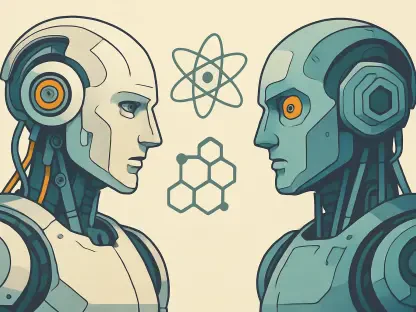Imagine a world where the smallest particles defy every rule of logic that governs our daily lives, behaving in ways that seem more like science fiction than reality, and quantum physics, the study of matter and energy at the tiniest scales, unveils this bizarre universe. Here, particles can exist in multiple states at once, influence each other across vast distances, and change simply by being observed. This field, though often perceived as an impenetrable maze of complex theories, is not just the playground of scientists in secluded labs. It underpins the technology shaping modern life and holds the key to groundbreaking innovations that could transform society in the coming years. Far from being an abstract concept, quantum physics touches everything from the smartphones in our pockets to the promise of ultra-secure communication networks. This exploration aims to break down the barriers of intimidation surrounding the subject, offering a clear path through its strangest principles and most exciting possibilities. By stripping away the jargon and focusing on the core ideas, the goal is to make this enigmatic science accessible to anyone with a spark of curiosity. Prepare to challenge long-held assumptions about how the world works and discover that what seems like magic is, in fact, a well-tested reality waiting to be understood.
Unraveling the Essence of Quantum Science
At its heart, quantum physics is the branch of science dedicated to understanding the behavior of matter and light at the atomic and subatomic levels, a realm far removed from the familiar physics of everyday objects. Unlike the predictable laws that explain why an apple falls from a tree, the rules here are anything but intuitive. Particles at this scale can act both as solid objects and as waves, blurring the lines of what seems possible. This peculiar nature isn’t a mere curiosity; it has been rigorously confirmed through experiments that consistently defy common sense. Quantum physics provides the framework for deciphering how the building blocks of the universe interact, even when those interactions challenge basic perceptions of reality. It’s a field that demands a shift in thinking, asking for acceptance that the smallest components of nature operate under a different set of guidelines. This foundation is crucial for grasping why quantum phenomena seem so alien yet are vital to modern advancements. By focusing on these fundamental differences, the subject begins to reveal itself as less of a mystery and more of a new lens through which to view the cosmos.
Beyond the initial strangeness, the significance of quantum physics lies in its ability to explain phenomena that classical science could not address. The field emerged as a necessity when traditional models failed to account for behaviors observed in light and matter at minute scales. Concepts like energy existing in discrete packets, rather than a continuous flow, revolutionized scientific thought and paved the way for technologies now taken for granted. This science isn’t just about abstract theories; it’s a proven system that underpins critical aspects of electronics, medical imaging, and more. Understanding this discipline means recognizing its dual role as both a challenge to conventional wisdom and a cornerstone of practical innovation. Experts in the field emphasize that while the principles may feel counterintuitive, they are supported by a wealth of empirical evidence. This balance of oddity and reliability makes quantum physics a compelling subject, bridging the gap between the unseen world and tangible outcomes. As this exploration unfolds, the focus will shift from mere definition to the historical roots that shaped these groundbreaking ideas, setting the stage for a deeper dive into their implications.
Tracing the Roots of Quantum Discovery
The story of quantum physics begins in the early 20th century, a time when scientists grappled with mysteries that classical physics couldn’t solve, particularly around the behavior of light and matter at the smallest scales. Pioneers like Max Planck introduced the radical idea that energy doesn’t flow continuously but comes in tiny, discrete units called quanta, a concept that shattered existing paradigms. Shortly after, Albert Einstein expanded on this by proposing that light itself could be thought of as particles, termed photons, offering an explanation for phenomena that had baffled researchers. These early breakthroughs weren’t just theoretical musings; they were responses to experimental data that refused to fit into old models. This period marked the birth of a new scientific era, one where the very nature of reality was questioned and redefined. The contributions of these early thinkers laid a critical foundation, proving that the universe operates under rules far stranger than anyone had imagined. Their work sparked a wave of curiosity and investigation, driving further discoveries that continue to shape scientific understanding today.
Building on these initial revelations, subsequent scientists like Niels Bohr and Erwin Schrödinger pushed the boundaries even further, developing models and equations that captured the probabilistic nature of quantum behavior. Bohr’s atomic model suggested electrons occupy specific energy levels, while Schrödinger’s famous equation provided a mathematical way to predict how quantum systems evolve over time, relying on probabilities rather than certainties. These advancements weren’t merely academic; they were grounded in experiments that consistently validated the odd predictions of quantum theory. The realization that particles could exhibit wave-like properties added another layer of complexity, challenging scientists to rethink fundamental concepts of matter. This historical progression highlights a pattern of iterative discovery, where each new idea built upon the last, often in response to contradictions in established thought. The impact of these developments reverberates through modern science, influencing everything from basic research to cutting-edge technology. This journey through history sets the stage for exploring the specific quantum principles that continue to captivate and confound.
Exploring the Strange Quantum Principles
Delving into the core of quantum physics reveals a set of principles so bizarre they seem to belong in a fantasy novel, yet they are firmly rooted in experimental reality. One foundational concept is quantization, the idea that energy exists in distinct, indivisible packets rather than a smooth continuum. Picture a light switch that doesn’t gradually brighten but jumps between set levels of illumination—this is how energy behaves at the quantum level, defying expectations shaped by everyday experience. Another striking principle is superposition, which allows a particle to exist in multiple states simultaneously until it is observed or measured. This isn’t just theory; it’s a phenomenon that has been tested and confirmed, underpinning much of quantum mechanics. These ideas challenge the very notion of a fixed reality, suggesting that the universe at its smallest scale operates under a logic all its own. Grasping these concepts requires setting aside preconceived notions and embracing a world where certainty gives way to possibility, a shift that is as intellectually stimulating as it is unsettling.
Another layer of quantum weirdness comes with entanglement, a phenomenon where two particles become so deeply connected that the state of one instantly influences the other, regardless of the distance between them. This connection, often described as spooky by even the most seasoned scientists, was once debated fiercely but is now a verified aspect of quantum behavior with potential applications in secure communication. Adding to the intrigue is the role of measurement, where the act of observing a quantum system fundamentally alters its state. This ties into Heisenberg’s Uncertainty Principle, which states that certain properties, like position and momentum, cannot be precisely known at the same time. The implications of these principles extend beyond mere curiosity; they form the basis for emerging technologies that could redefine how information is processed and protected. Together, quantization, superposition, entanglement, and the effects of observation paint a picture of a universe far more complex and interconnected than the one encountered in daily life. These strange rules are not anomalies but the very fabric of reality at its most fundamental level, opening doors to both philosophical questions and practical innovations.
The Impact of Observation on Quantum Reality
One of the most perplexing aspects of quantum physics is the profound effect that observation has on the systems being studied, a concept that fundamentally distinguishes this field from classical science. When a particle’s properties, such as its position or speed, are measured, the act of measurement itself disrupts the system because it requires some form of interaction, like a photon striking a detector. This isn’t a minor inconvenience but a core feature of nature at these scales, encapsulated by Heisenberg’s Uncertainty Principle, which asserts that knowing one aspect of a particle with precision inherently limits knowledge of another. The idea that reality at the quantum level is shaped by the very act of looking at it challenges traditional views of an objective, independent world. This phenomenon forces scientists to grapple with the limits of what can be known, turning measurement into an active participant in the unfolding of quantum events rather than a passive tool. Such a principle underscores the unique difficulties in studying and predicting quantum behavior, highlighting a reality far removed from everyday experience.
This intrinsic link between observation and outcome also ties directly into the concept of superposition, where a particle exists in multiple potential states until a measurement collapses it into a single, definite state. This isn’t just a theoretical quirk; it’s a tested reality that reveals how interconnected observation and quantum systems are. The implications ripple outward, affecting how experiments are designed and interpreted, as any attempt to gather data inevitably alters the subject of study. Beyond the laboratory, this principle raises deeper questions about the nature of reality itself—does the universe require an observer to take shape, or does it exist independently in a state of potential? While these philosophical debates remain unresolved, the practical effects are undeniable, influencing the development of technologies that must account for the observer effect to function correctly. This dynamic between watching and changing underscores the delicate balance at play in quantum research, where understanding comes with the cost of interference, reshaping how science approaches the smallest building blocks of existence.
Quantum Technology: Bridging Theory and Application
The relevance of quantum physics extends far beyond academic curiosity, as it already forms the backbone of technologies integral to modern life and promises even more transformative innovations on the horizon. Semiconductors, which power everything from laptops to smartphones, owe their functionality to quantum principles like wave-particle duality, which governs how electrons behave in materials. Similarly, solar cells and medical imaging devices rely on the precise understanding of quantum interactions between light and matter. These examples illustrate that quantum science isn’t a distant theory but a driving force behind tools used every day. As researchers continue to unravel the intricacies of quantum behavior, the impact on society becomes increasingly evident, with established technologies serving as a testament to the field’s practical value. This intersection of abstract science and real-world application highlights the importance of continued exploration, as each discovery builds on the last to enhance technological capabilities in ways previously unimaginable.
Looking ahead, the potential of quantum physics to revolutionize entire industries is becoming clearer, with developments in quantum computing, cryptography, and sensing technologies leading the charge. Quantum computers, which leverage superposition and entanglement to process information at unprecedented speeds, could solve complex problems far beyond the reach of classical machines, though fully functional systems are still some years away. Meanwhile, quantum sensors offer unparalleled precision, with applications ranging from navigation systems that could rival GPS to medical diagnostics capable of detecting minute changes in biological systems. Additionally, quantum cryptography promises communication networks that are virtually unbreakable, a critical advancement in an era of increasing digital threats. These emerging fields, often referred to as the second quantum revolution, demonstrate how the strange rules of the quantum world can be harnessed for tangible benefits. The momentum behind these advancements, supported by global research initiatives, suggests that quantum technology will play a pivotal role in shaping the future, transforming challenges into opportunities for innovation across diverse sectors.
Reflecting on Quantum Insights and Future Horizons
Looking back, the exploration of quantum physics revealed a landscape where the smallest elements of nature operated under rules that defied conventional understanding, yet proved their validity through rigorous experimentation. The journey through history showcased how early 20th-century scientists dismantled outdated models to build a framework that accounted for the peculiarities of light and matter. Concepts like quantization, superposition, and entanglement emerged not as mere oddities but as fundamental truths that reshaped scientific thought. The realization that observation itself altered quantum systems added a layer of complexity, challenging notions of an unchanging reality. Meanwhile, the transition from theory to technology demonstrated the profound impact of these principles on everyday tools and future innovations. This retrospective highlights a field that, despite its initial strangeness, stood as a cornerstone of modern progress, validated by decades of empirical success.
As this reflection concludes, attention turns to the actionable steps and future considerations that can further demystify quantum physics and amplify its benefits. Encouraging educational initiatives that simplify these concepts for broader audiences could bridge the gap between complex theory and public comprehension, fostering greater interest and involvement. Investment in research and development, particularly in quantum computing and secure communication, remains essential to overcome current technical barriers and bring ambitious ideas to fruition. Collaboration across international scientific communities will also be key to accelerating discoveries and ensuring that quantum advancements address global challenges, from healthcare to cybersecurity. By focusing on these pathways, society can move toward a deeper integration of quantum principles, turning what once seemed like an arcane science into a familiar force for innovation and understanding in the years ahead.









